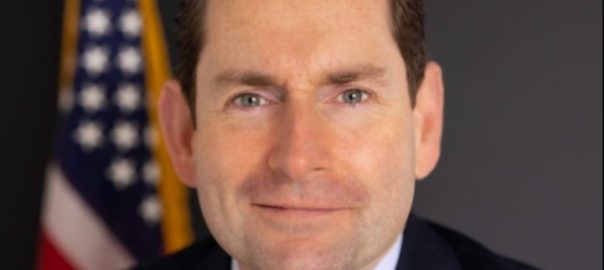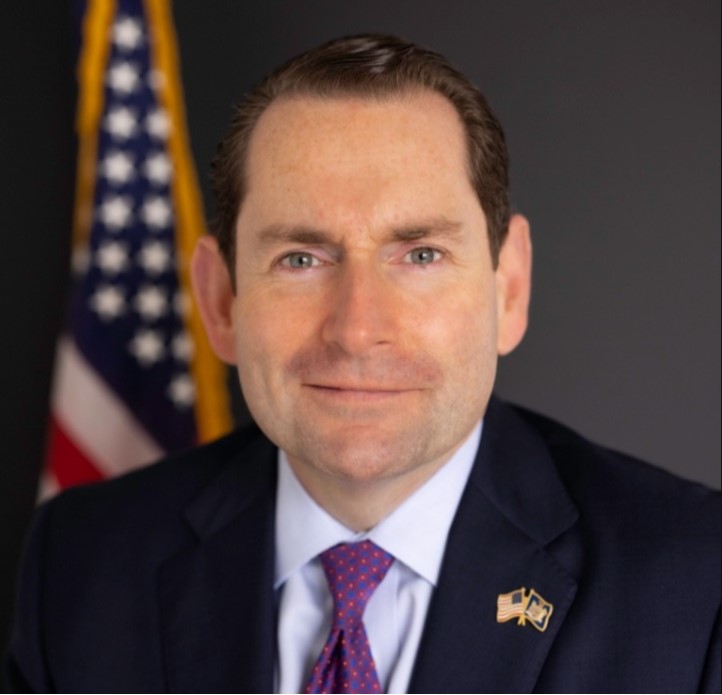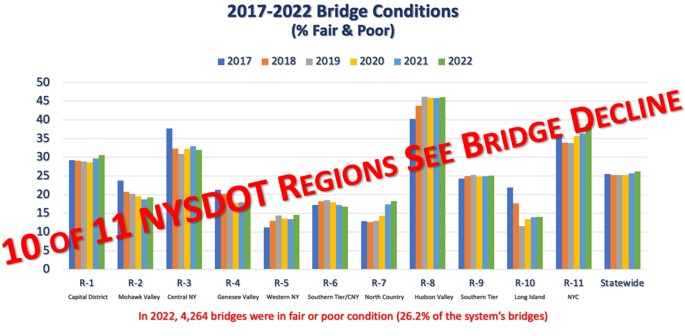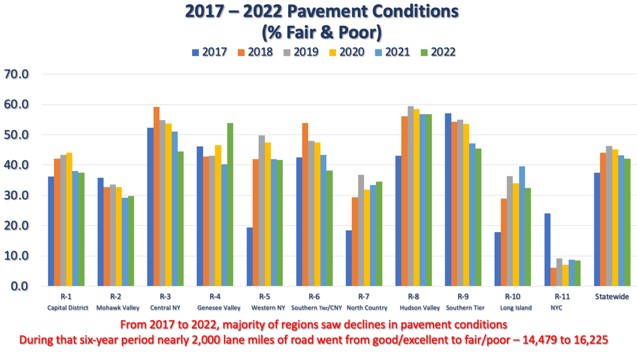
Business, Labor and Government Leaders Agree: NYSDOT Capital Plan Needs Infusion to Overcome Inflation & Slow Decline of Bridges and Roads
We are approaching the two-year anniversary of the historic Bipartisan Infrastructure Bill—known as the Infrastructure Investment and Jobs Act (IIJA). New Yorkers played a pivotal role in getting this done—and in true bipartisan fashion, with our own Senate Majority Leader Chuck Schumer and former Representative John Katko playing lead roles in pulling a deal together—and Representatives Nicole Malliotakis and Andrew Garbarino being among the Republicans who courageously crossed party lines to do what was right for New York and America’s infrastructure.
Representing the biggest federal investment in transportation infrastructure since President Eisenhower built the interstate system, this landmark legislation allowed Governor Hochul and the Legislature to two years ago enact a record $32.8 billion five-year New York State Department of Transportation (NYSDOT) Capital Program to rebuild New York’s deteriorating road and bridge system.
Great news, right? Our roads and bridges should literally be on the, well, road to recovery, no?
Unfortunately, no.
All this positive news also coincided with a perfect storm of record inflation, construction material cost escalation and supply chain disruptions. These factors have taken a huge chunk out of the spending power of the NYSDOT Capital Program—an inflationary impact of more than 20%. In other words, a whole year of the five-year Capital Program has gone up in inflationary smoke. It could have been even worse, as the Federal Highway Administration has pegged its highway construction inflation index at 50% nationwide!
Without additional investment, the discussion will turn to which projects to cancel or delay, as with a year’s worth of funding consumed by inflation, the Capital Program will run out of money before it runs out of projects.
Our roads and bridges can’t withstand that. NYSDOT’s own conditions reporting tells us that in the last year, a staggering 10 of 11 NYSDOT regions saw a decline in their bridge conditions. This is unprecedented—and means more than a quarter of the NYSDOT systems bridges are in fair or poor condition.
Our pavement conditions are in trouble, too, which is hardly news to New Yorkers all too accustomed to dodging potholes. Over the last 5 years, most regions saw their pavement conditions decline, with nearly 2,000 miles of roadway deteriorating from good/excellent condition to fair/poor condition.
New Yorkers and our economy can’t afford this decline, either. The average motorist pays an extra $1,600 every year in extra costs—including replacing flat tires and bent wheels—totaling $28 billion annually, according to the national transportation research organization TRIP. We call it the “Pothole Tax.”
Ultimately, this all amounts to a bigger hit to the state budget as well. NYSDOT reports it costs sixteen times more to repair a road that has been allowed to deteriorate to poor condition than it costs to maintain a road that is in good condition. We will pay now or pay much, much more later to fix our infrastructure.
The stark reality is that without additional investment this year, because of inflation we are on our way to worse road and bridge conditions in New York than before the enactment of both the historic Bipartisan Infrastructure Bill and Governor Hochul’s record NYSDOT Capital Program.
We cannot allow that to happen—and Governor Hochul and the Legislature can and must take steps this year to insure it does not. That’s why an incredibly broad and diverse coalition representing business, labor, local governments, construction and a broad array of critical sectors of New York’s economy have joined together to urge the Governor, Senate and Assembly to increase funding for core NYSDOT capital needs by at least $400 million in this year’s budget process. (You can read the letter at this link.)
The breadth of this coalition shows just how critical this issue is for the entire state. Whether it’s a small business owner, member of the building trades, a large company, a farm, local government leader or an inn keeper supporting your local economy through tourism, they all know just how much the condition of our roads and bridges matter. It sustains our economy, gets goods and services to consumers, our kids safely to school—and puts tens of thousands of New Yorkers to work in great paying jobs in the process.
Because of the devastating impact of inflation, this additional funding is needed in the 2024-25 budget for core highway construction just to keep funding at a similar level to when the five-year program was initially adopted in 2022.
We understand and appreciate the significant fiscal challenges presently confronting the state, which is why we are seekining the minimum amount necessary to slow the rate of decline on our roads and bridges.
Simply put, everyone relies on NYSDOT’s statewide system of roads and bridges to survive and thrive. The Governor and Legislature must act now to improve their conditions to strengthen our economy and sustain and create jobs, today and into the future. We need to Rebuild NY Now—and with the Governor and Legislature’s support this year, we can take a crucial step toward doing just that.
Mike Elmendorf is President & CEO of the Associated General Contractors of New York State (AGC NYS), New York’s leading statewide construction industry association, and President of Rebuild NY Now, a broad-based coalition that includes business, labor, municipalities and others advocating for increased infrastructure investment.



